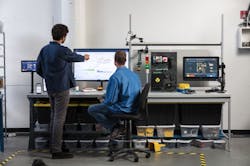In this digital age of enterprise-based self-service apps, it is only a matter of time until that same model makes it to the factory floor. And, that time is now.
Manufacturers are finally beginning to get a glimpse into their future using the same easy-to-access applications on the plant floor. Last month, for example, PTC introduced ThingWorx 8, the newest version of its Industrial Internet of Things (IIoT) platform that includes role-specific manufacturing apps that are fast to deploy—with codeless app extensibility—providing real-time operational intelligence.
This month, Tulip, an MIT spinout founded in 2014, announced $13 million in series A financing to build out its Manufacturing App Platform, a code-free development environment. The software is used by engineers to build their own IoT-enabled apps for a variety of use cases including interactive work instructions, automatic data collection, quality control, audits, machine monitoring and training.
Tulip’s technology is not meant to replace manufacturing software, but enhance it to be user-friendly. The systems currently in place, like a homegrown manufacturing execution system (MES), are often fragmented and difficult to use. As a result, instead of leveraging the built-in information-generating capabilities, operators revert to recording data with the tools that are comfortable to them: pencil and paper or spreadsheets.
“We think the problem we are solving is endemic to manufacturing,” said Yuval Marcus, operations lead at Tulip, noting that people don’t always have easy access to the information required to do their jobs. “We focus on the human aspect of things and trying to connect operators with machines, sensors, tools and the existing IT stack that manufacturers are running.”
Tulip is an operating system for the digital shop floor. The technology enables the creation of sophisticated workflows to connect CNC machines, vision systems, torque guns, for example, with the operators. It also collects data from every aspect of the process with a dashboard displaying KPIs for all to see.
“We’ve seen self-service in analytics where people can create analytics apps if they are provided simple, intuitive tools,” said Marcus. So, why not provide the same kind of tools for training technicians on standard operating procedures or for building product or tracking quality defects? “This is a self-service tool that a process or quality engineer can use to build apps. They can create sophisticated workflows without writing code.”
In addition, the Tulip IoT gateway allows anyone to add sensors, tools, pick to light bins and cameras to the work station, also without writing a line of code, as factory floor devices are supported through a library of drivers.
Now, engineers can design a process for operators that visually guides them through each task while collecting data on the operation via sensors, for example. Or, an operator can take a picture of a part to feed a visual back into the system. For process improvement, that same sensor-driven machine data can be connected to ERP and MES systems to compare against quality metrics. And applications around self-guided training of “if-then” scenarios, include messages and alerts, to keep everyone on track.
The platform is particularly good for training employees. Tulip worked with life sciences company Merck to help train newly hired operators on complex lab equipment that is subject to quality standards and regulations. In the past, new operator training relied on paper-based work instructions and required the trainer to directly supervise each trainee. Using Tulip, engineers created interactive training apps with step-by-step work instructions that included photos, videos and live stream sensor data to guide the operators.
The result: The cost of training new operators was reduced by over 57 percent and there was a 92 percent time savings over the time previously devoted to training new operators.
The results are so compelling that McKinsey & Co., which announced the launch of its North American Digital Capability Center (DCC) in collaboration with the Digital Manufacturing and Design Innovation Institute (DMDII), has brought Tulip on as a key partner. The DCC is a unique digital manufacturing learning center where participants receive hands-on training on a mock production line, transforming—in stages—from a current, non-digitized line into a digitally-driven process. The operators are able to experience advanced analytics, augmented reality, and, using Tulip, digital operator assistance.
The manufacturing application used by McKinsey demonstrates integrations with machine vision systems, torque screw drivers, pick to light systems and break beams. The goal is to show that when operators have the right information at the right time it reduces errors, increases speed and ultimately facilitates continuous improvement.
Tulip’s analytics engine is designed specifically for manufacturing including contextual information in dashboards. To that end, the engine knows there is something called ‘downtime’ or ‘operator’ or ‘process’ which a business tool would not necessarily understand, Marcus said.
Currently, Tulip has about 20 customers for this subscription-based software and the benefit of the self-service manufacturing apps, they say, is having more quality time. “Engineers are spending 40 percent of their time doing value-added stuff vs. chasing data or talking to people trying to figure out what went wrong,” Marcus said. “They are spending their time better.”
About the Author
Stephanie Neil
Editor-in-Chief, OEM Magazine

Leaders relevant to this article:
